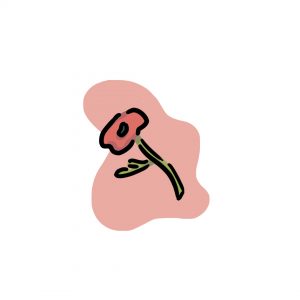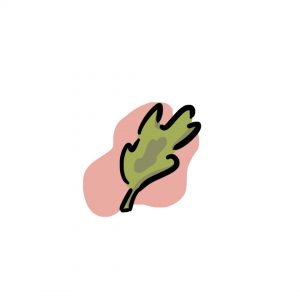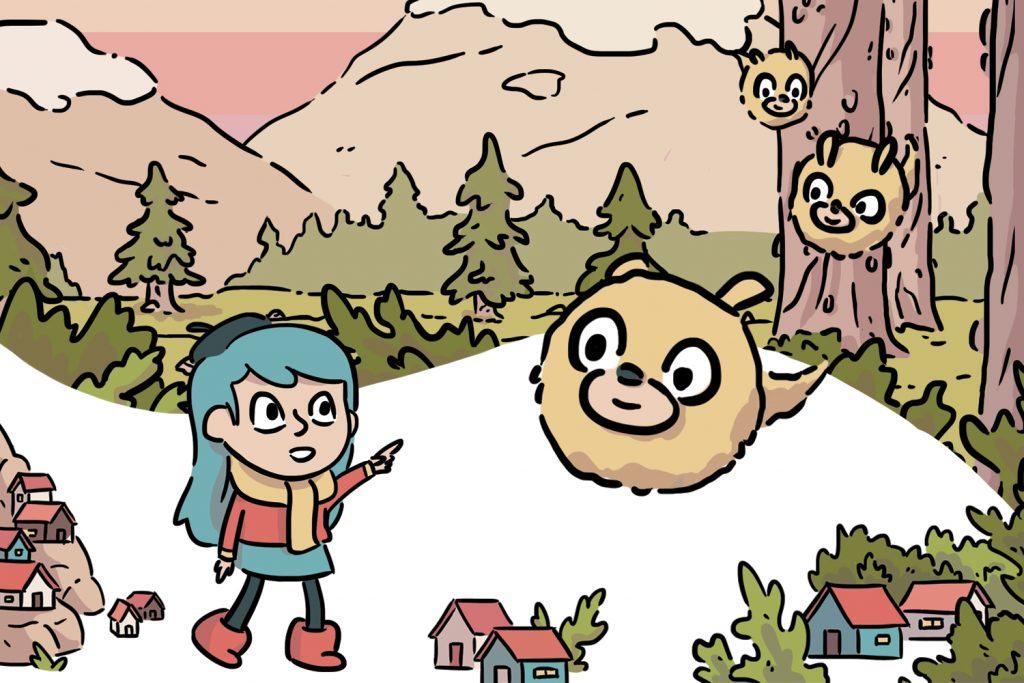Amid forest foliage and maroon hues, a young girl and her pet deer-fox scramble through grassy woods as a towering troll lumbers after them. Their ragged breaths tear through the darkening forest. But the girl laughs, taking in the thrill as she dashes over outlined logs and animated waterfalls under a sunset painted in stripes of deep colors.
This is just one of the many stunning scenes from the award-winning Netflix Original “Hilda.” First created as a comic book series in 2010 by Luke Pearson, “Hilda” was later adapted by the streaming service in 2018 as an animated television series.
The show follows a young, adventurous girl named Hilda as she explores a Scandinavian folklore-inspired world and works to help the people and creatures around her. Along with her friends, she encounters paperwork-loving elves, enchanted mice and sassy teenage spirits as she travels from the open mountainside to her new home in a thriving suburban city. With the second season set to release on Dec. 14, we’re looking back on the beautiful colors and heartwarming story in the fantastical world of “Hilda.”

The show opens with a bright title sequence featuring a fluid runthrough of the series. Literally. Together with her friends and key characters, Hilda runs through scenes and locations that turn up throughout the season. The show’s unique colors and design immediately shine through in the brief 30 seconds. Set to a light, bubbly theme song by electropop musician Grimes, viewers get a taste of the spirited, smooth and stylistic aesthetic that “Hilda” totes.
The show doesn’t have a single running storyline, and instead features individual episodic stories. One episode sees Hilda helping a talking bird regain its memory, while the next covers her adventures with community service and onion men. But the story is continuous: pieces of each episode are masterfully woven throughout the entire series. The service organization Hilda joins is foreshadowed in her adventures with the bird, and both episodes establish later events. Everything leads up to the final episode — an exciting finale that ties up the season nicely.
While many children’s shows push the moral of the story in a way that can seem forced, “Hilda” delivers heartfelt lessons in a form that can appeal to all. There are more to the themes than the usual “power of friendship.” In one episode, viewers come to realize — along with the characters — the message about Hilda finding her real home. Suddenly, previous elements like conversations with an old friend and Hilda’s general attitude about moving to the city all click together. These positive endings leave viewers feeling satisfied, a nice break from the dramatized cliffhangers that keep you clicking “Next Episode.”
“Hilda” delivers heartfelt lessons in a form that can appeal to all.
“Hilda” is set in a world that is both modern and fantastical, a combination that isn’t often seen together. But the genres don’t clash: instead, they twist together in an artful duet. In one scene, cruise ships lie in a harbor next to historical sailboats. In another, police rush by in capes, feathered hats and flashing police cars. It brings a sense of relevance to the folklore-based story and a bit of magic to the world we know today.

Traditional aspects are also refurbished through the show’s modern, minimalist art. It’s here that “Hilda” pushes the boundaries of television. Broad fields of color and clean, rounded lines sketch out iconic scenes in a style that’s more often seen in graphic design. The show’s comic book origins reveal themselves through these stunning visuals. And while not overly bright or saturated, the muted color scheme still feels lively and wondrous. Rays of golden sunlight or beams from glowing headlights illuminate every single scene, further dazzling audiences. Animation is certainly an art, and “Hilda” is one of the shows that reinforces that connection.Fluid animation adds further depth to scenes. While the art is not hyper-realistic, the show’s creators bring Hilda’s world to life: every movement is elegant, every word is pronounced and every blink is smooth. Animation extends into backgrounds, from the smallest mote of dust to waves dancing on the shore. No corners were cut and the result is a beautiful, mobile, living world.
This investment is also reflected in the characters. Despite lacking live human actors, “Hilda” boasts well-developed personalities. One of the strongest relationships in the show is between Hilda and her mother, Johanna. Rather than being depicted as a stiff, unrelatable figure or the face of opposition as many parents are in television, Johanna is clear-headed and practical, bearing both the responsibility and love that comes with parenting. No matter what Hilda gets into, her mother is there for her and full of support. She’s also a graphic designer, tying nicely with the show’s aesthetic and breaking the “boring parent job” convention.
Still, while emotionally dimensional, the human population is a bit uniform. More ethnic diversity in the main and recurring characters would elevate the show. In a series about accepting and understanding others, whether human characters or fantasy creatures, representing more communities would only enhance the message.
Animation is certainly an art, and “Hilda” is one of the shows that reinforces that connection.
Viewers looking for violent action or edgy drama will not find it in “Hilda.” What they will find is a heartfelt series that captures the essence of being a child. But that doesn’t mean animation is only for kids. The show reflects a larger revival of animation; over the last few years, streaming services like Netflix, Amazon Prime Video and Hulu have bumped up their investment in the genre. And with the arrival of Disney+ in late 2019, animation has taken hold of today’s entertainment industry. Perhaps the beautiful art has attracted the world’s eye. Perhaps it reflects a larger trend of desire for positivity. Either way, shows like “Hilda” uplift their audience, something we all need especially now.
Audiences should anticipate even more from the world of “Hilda”; the second season is set to explore deeper themes on a broader scope. Viewers will see Hilda settling into city life while facing an antagonist, aspects that weren’t present in the first episodes. Returning characters will also see new stories, such as an episode dedicated to Hilda’s pet deer-fox Twig. Expectations are high for the team behind “Hilda,” but based on their previous work, many predict they won’t disappoint.
Whether looking for the next animated series or just anything to watch, “Hilda” is an exciting, intricate show for audiences of all ages. A heartwarming story is at the core of its fluid animation and stunning design, reminding us of the wonder of living and growing in a magical world. And these days, we could use a little magic in our life.
RELATED STORIES
Disney’s dilemma: A beloved film company’s new direction
Is this the sound of the end of the world?: Why “Miss Anthropocene” is a prophecy worth listening to




